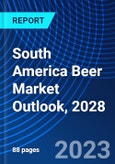This report comes with 10% free customization, enabling you to add data that meets your specific business needs.
1h Free Analyst TimeSpeak directly to the analyst to clarify any post sales queries you may have.
According to the research report South America Beer Market Outlook, 2028, the market is anticipated to add more than USD 37.93 Billion from 2023 to 2028. The demographics and consumer preferences in South America have changed. Younger generations are discovering craft beer options, embracing new and diverse beer styles, and looking for unusual flavor sensations. The expansion of the craft beer market and the emergence of more creative and artisanal brewers are both results of this demographic transition. South American brewers and beer enthusiasts are fueling the growth of the craft beer industry. Craft breweries provide distinctive and cutting-edge beer selections that highlight regional flavors and ingredients. The beer market has grown as a result of the rising demand for craft beer, giving customers more options and encouraging experimentation as well as an appreciation for quality and craftsmanship.
Brazil stands out as the leading nation in terms of beer production and consumption in the South American region. Brazil currently holds a prominent position in the industry thanks to its sizable population and robust beer culture. The nation is home to a number of significant brewers, both domestic and foreign, and provides a wide range of beer varieties to accommodate various consumer preferences. Another event that demonstrates Brazil's love of beer is Oktoberfest in Blumenau, one of the biggest beer festivals in the world. Although Brazil dominates the South American beer industry, Argentina, Colombia, and Peru also have sizable beer businesses and contribute to the lively beer culture in the region. Although beer is the preferred alcoholic beverage in South America, individual tastes might still differ. On the basis of individual preference, cultural background, or particular events, some people may like alternative alcoholic beverages such as wine, spirits, or traditional regional drinks.
Lager beers frequently have a crisp finish, are lighter in flavor, and are refreshing. They are frequently consumed in South America because they are easy to drink. In nations like Brazil, Argentina, and Colombia, respectively, popular lager brands like Brahma, Quilmes, and Aguila are loved. Pale ales, IPAs (India Pale Ales), and amber ales are only a few of the many beer varieties categorized as ales. Standard and premium beer preferences might differ between nations and even between regions of South America. Craft and specialty beers have seen a rise in popularity in recent years, which has boosted the need for high-end options. This has caused a proliferation of neighborhood microbreweries and increased access to craft beer options in some regions.
In South America, beer is traditionally and extensively packaged in glass bottles. They are available in several sizes, including 330 ml, 600 ml, and 1 liter. In recent years, beer in cans has become more common across South America. Aluminum cans have benefits such as improved light and oxygen protection, simplicity in transporting, and convenience. In different South American nations and areas, people may prefer large-scale production to craft brewing. Craft beer has grown significantly in popularity and strength in some nations, while industrial-scale production may rule the market in other nations. Breweries that operate on a smaller scale than industrial breweries but may not adhere to the exact definition of craft brewing exist as well. These establishments are frequently referred to as microbreweries or Nano breweries, and they fall somewhere between these two categories.
The beer market is governed by a unique set of national laws in South America. These rules cover things like taxation, age restrictions, alcohol content and labelling, advertising and marketing, production requirements, and import and export laws. The beer business is supported and represented by a number of legal groups in South America. Authorized organizations include the Argentine Craft Beer Association (Asociación de Cerveceros Artesanales Argentinos, ACARA) and the Brazilian Beer Association (Associaço Brasileira da Indstria da Cerveja, CERVBRASIL) in Argentina and Brazil, respectively. Breweries in South America engage in regional, national, and worldwide beer competitions to exhibit their goods and gain reputation. The South American Beer Cup (Copa Sul-Americana de Cervejas) and the Brazilian Beer Cup (Concurso Brasileiro de Cervejas) are notable beer contests in South America. The market is fragmented with the presence of international players and numerous local breweries in the region. Players in the market are focusing on increasing product offerings and introducing microbreweries across the region. A few of the major players in the market include Anheuser-Busch InBev, Heineken N.V., Carlsberg Group, Columbia Craft Brewing Company, and Novo Brazil Brewing Company.
Considered in this report
- Geography: South America
- Historic year: 2017
- Base year: 2022
- Estimated year: 2023
- Forecast year: 2028
Aspects covered in this report
- South America Beer market with its value and forecast along with its segments
- Country-wise Beer Market analysis
- Various drivers and challenges
- On-going trends and developments
- Top profiled companies
- Strategic recommendation
Countries covered in the report:
- Brazil
- Argentina
- Colombia
By Product Types:
- Lager
- Ale
- Stout & Porter
- Malt
- Others(pilsner, hard seltzer, kegs, porter)
By Category:
- Standard Beer
- Premium Beer
By Packaging:
- Bottle
- Cann
By Production:
- Macro Brewery
- Micro Brewery
- Craft Brewery
By Distribution Channel:
- On Trade
- Off Trade
By Beverages Type:
- Alcoholic
- Non- Alcoholic







